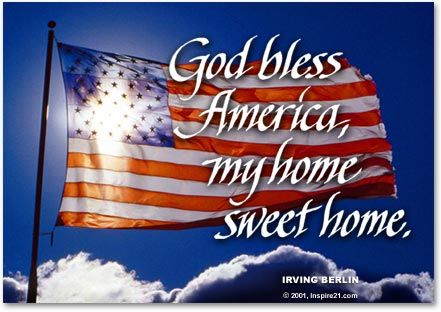
Our current flag, featuring 50 stars on a canton against the background of 13 stripes, 7 red and six white, has been in effect since July 4, 1960 – following the inclusion of Hawaii in the United States of America.
__________________________________________________________
Though the Flag Day was first celebrated in 1877, with the centennial of the U.S. flag's existence, the idea of making it a public celebration is believed to have originated in 1885.
In course of time a number of individuals and organizations advocated the adoption of a national day of commemoration for the U.S. Flag. However, B.J. Cigrand, a teacher from the Wisconsin Public School,District 6, is believed to be a forerunner of the thought. He organized the pupils in the Fredonia, to observe June 14 as 'Flag Birthday'. It was the 108th anniversaryof the official adoption of The Stars and Stripes, the first national flag of the United States. It was a bid to inspire and educate the school children with spirit of the Flag as well as love for the nation. And it was not a single shot bid. Cigrand continued to advocate the need for its observance in the following years through numerous magazinesand newspaper articles and public addresses. But the celebration was yet to take off in a well defined styleand in a wider scale.
On June 14, 1889, George Balch, a kindergarten teacher in New York City, planned appropriate ceremonies for the children of his school,and his idea of observing Flag Day was later adopted by the State Board of Education of New York.On June 14, 1891, the Betsy Ross House in Philadelphia held a Flag Day celebration, and on June 14 of the following year, the New York Society of the Sons of the Revolution, celebrated Flag Day.
Inspired by Colonel J Granville Leach, a historian,the Pennsylvania Society of Colonial Dames of Americaadopted a resolution on April 25, 1893. The resolution requested the mayor of Philadelphia and all others in authority and all private citizens to display the Flag on June 14th. Leach went on to recommend that thereafter the day be known as 'Flag Day'. It was also recommended that on that day, school children be assembled for appropriate exercises,with each child being given a small Flag.
As a result of the resolution, Dr. Edward Brooks, then Superintendent of Public Schools of Philadelphia, directed that Flag Day exercises be held on June 14,1893 in Independence Square. School children were assembled, each carrying a small Flag, and patriotic songs were sung and addresses delivered.
In 1894, the governor of New York directed that on June 14 the Flag be displayed on all public buildings. Meanwhile, with BJ Cigrand and Leroy Van Horn as the driving force, the Illinois organization, known as the American Flag Day Association, came into being.
Its purpose was to promote the holding of Flag Day exercises. And thanks to its initiative, on June 14th, 1894, the first general public school children's celebration of Flag Day in Chicago was held. More than 300,000 children participatedin the programs held in various parks across Chicago. Adults, too, participated in patriotic programs in different parts of the country. And the celebration registered increasing popularity as more and more localities and states over the next three decades.
The Proclamation of President Woodrow Wilson established it officially on May 30th, 1916. While Flag Day was celebrated in various communities for years following Wilson's proclamation, it was not until August 3rd, 1949, that the 14th of June was designated by President Harry Trumanas National Flag Day to be celebrated each year across the nation.
______________________________________________________________
Growing up in America, I have always thought that our flag was beautiful. The colors, the styling, etc. Vibrant Red of Valor, Bright Blue of Justice, Beautiful White of Purity and Innocence.
Now that I am actively involved in the military mindset though, the flag means so much more to me. I find myself actually coordinating complete outfits out of red, white and blue. It has actually become a challenge to me to try make cute patriotic outfits. Yes, I know I have issues! If Al doesn't get back from the sand soon, I'm scared that my patriotism may start to extend past my car, my house, my cubicle at work and my outfits --- I have a bad case of patriotic sprawl and I'm coming to get you. If you see me heading your way with those small miniature flags - watch out!! I'm like "The Borg" from Star Trek, 'Resistance is Futile'!!
Here is an excellent article on the meaning of Flag Day as intrepreted by Operation Iraqi Freedom veteran:
Iraqi Freedom Veteran Reflects on Meaning of Flag DayBy Capt. Steve Alvarez, USA
American Forces Press Service
WASHINGTON, June 14, 2005 – It's been a little more than two months since I returned from Iraq.
More than a year earlier I promised my wife I'd come home safely, and the day I returned, hours after I had come home, I watched my wife eagerly remove the Blue Star Service Banner that hung in our front window, and she happily watched me bring down the yellow ribbon that had hugged our yard's corner tree for a year.
The symbols of my family's hardship and sacrifice were now finally gone from the landscape of my neighborhood. Passersby and neighbors, noting the missing banner and yellow ribbon, stopped by and welcomed me home. My family's soldier was home, and the tattered, frayed ribbon that weathered three Florida hurricanes, and the banner that faded in the setting sun each day were now stowed for posterity.
Before I left Iraq, I, too, removed an item from display. It hung in the public affairs "hooch" at Phoenix Base in Baghdad, and also briefly in my quarters. The item had made the long journey from the United States to Iraq. Now back home, it sits far from the angry sounds of mortar, rocket and small-arms fire so familiar to soldiers in Iraq -- now also familiar to this flag. It is a U.S. flag flown over the U.S. Capitol on the day I became an Army officer.
Before my duty in Iraq, the flag served as a moral compass that guided me and kept my course true after I decided to leave the enlisted ranks and set my course on an officer's career path. It kept me focused and committed to the oath I took when I became a second lieutenant. I kept it within eyeshot in my office. Looking at it as I weighed options more than once helped me make sound military, personal and ethical decisions.
In Iraq, the flag was still a source of direction. The enemy routinely attacked us using indirect fire. On one occasion a round hit our compound, but did not explode. But another hit so close that the wall-draped flag waved slightly from the blast that violently shook the walls.
I looked around the hooch as we hugged the floor, and for some strange reason I felt reassured, safe. "It's going to be fine," I told my soldiers. I stared at the colors as the mortars continued to hit, and found an immense source of strength. I was never able to explain it, but every time we were attacked, if I was in the hooch, I always looked to that flag for a sense of peace, for stability, to keep me focused and grounded.
When I was in Fallujah, Iraqi security forces raised their nation's flag in a scene reminiscent of U.S. Marines raising the flag at Mount Suribachi on Iwo Jima, Japan, in World War II. Having seized Fallujah's hospital, one of the major objectives in Operation Al Fajr (Arabic for "dawn"), Iraqi special forces lifted their nation's colors, and in doing so lifted their comrades' spirits. And while the raising of the Iraqi flag inside of Fallujah's city limits was not as dramatic as the Marines raising the U.S. flag in the Pacific, to me, an officer sent to Iraq to help support the training of Iraqi security forces, it was equally inspiring.
As I served in Iraq, I wore the U.S. flag on my uniform. The flag accompanied me as I traveled the sometimes-dangerous streets of Iraq and flew with me in Iraq's not-so-friendly skies. My U.S. flag patches are the only patches from my uniform that I have kept.
Now, symbols of my war service, like my flag patches, are securely tucked away in a keepsake box, and my commissioning flag sits on a shelf in our den encased in wood and glass. Someday I'm sure they will again serve as a source of inspiration.
But today is Flag Day. And for my family, our house is not our home without the flag waving gently, quietly, proudly in the breeze on our front porch. For us, our flag symbolizes that we are free to do what we want, when we want. It represents freedom of spirit, who we are, what we stand for, and what we're willing to endure for liberty.
That's what kept me focused in Iraq and kept me believing in our mission. To me, the flag represents my family, our way of life -- many, united as one. And maybe that's what Flag Day is all about. The flag is something different to everyone, and in that disparity there is unity, a bond.
I've returned to my life as a part-time soldier, and I am in Washington performing my annual training. It comes as no surprise that on my son's first visit to Washington, the first two places we visited were the Marine Corps War Memorial and the National Museum of American History.
The Marine Corps War Memorial, which depicts that famous World War II flag raising, now reminds me of the nascent Iraqi forces raising their country's colors in Fallujah. The symbolism behind the monument has become, for me, one and the same with the symbolism of that moment in Fallujah.
And draped at the entrance of the National Museum of American History is a symbol of sorrow, resolve, determination and inspiration -- the mammoth flag that covered the span across the Pentagon's damaged walls the morning after Sept. 11, 2001.
And as expected, the encased flag in my den and the flag patches I wore on my uniform are once again serving as a source of inspiration.
You are, after all, reading this article.
(Army Reserve Capt. Steve Alvarez was public affairs officer for Multinational Security Transition Command Iraq.)
Visual history of the United State's Flag:
The Grand Union Flag:
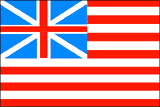
It showed the British Union Flag of 1606, the predecessor of the Union Jack, in the canton. Its field consisted of seven red and six white alternated stripes representing the 13 colonies. The latter officially replaced it on June 14, 1777.
Don't Tread on Me:

There were some other early versions of the Flag. A very popular one among them was, the first Navy Jack. It had the 13 red-white stripes with a rattlesnake overall, and the motto"Don't Tread on Me."
The 1st national Flag:
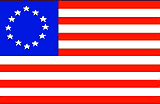
Called the Stars and Stripes, this was formally approved by the Continental Congress--on June 14, 1777. The blue canton was to contain 13 stars, but the layout of the stars was left undefined, and several patterns are known.The one designed by the legendary Betsy Ross is said to feature the stars arranged in five rows of either two or three stars.
The Navy adopted its own flag:
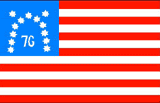
Some related designs that followed soon, include the 76 Flag. It was flown at the Battle of Bennington on Aug. 16, 1777.
Hulbert's Stars and Stripes:

Yet another contemporary flag that was cast in the mold of the Stars and Stripes was the one designed by John Hulbert, a magistrate. It's stripes were the same but the canton featured a diamond-shaped field of 13 stars was.
The Stars and Stripes - 1795 version:

Stars and Stripes remained unchanged until May 1, 1795, when two more stars and two more stripes were added to reflect the admission to the union of Vermont (1791) and Kentucky (1792). It was this flag that inspired Francis Scott Key to write the "Star Spangled Banner".
Stars & Stripes - 1818 version:

In 181 8, with five more states being admitted, the Congress enacted legislation. This stated that henceforth the stripes should remain 13, whereas the number of stars should always match the number of states. It was also decided that any new star should be added on the July 4 following a state's admission. This has been the system ever since.
The 1863 version:
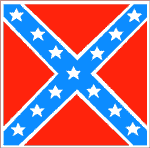
On May 1, 1863, a new national flag, the Stainless Banner was adopted. However, the design did not last long.
The 1865 version:

But a still short lived was a modification of the Stainless Banner. It was adopted, rather futilely, about a month before the end of the war in April 1865.
Stars and Stripes - standardized version:

Since then every time a new state was annexed, the size of the canton, as well as the stripes got altered, so as to accommodate the increased number of stars. It took to Oct. 29, 1912, when an executive order standardized the proportions and relative sizes of the elements of the flag. However, the exact shades of color of the elements were yet to be standardized. And it took till 1934 to standardize this.




No comments:
Post a Comment